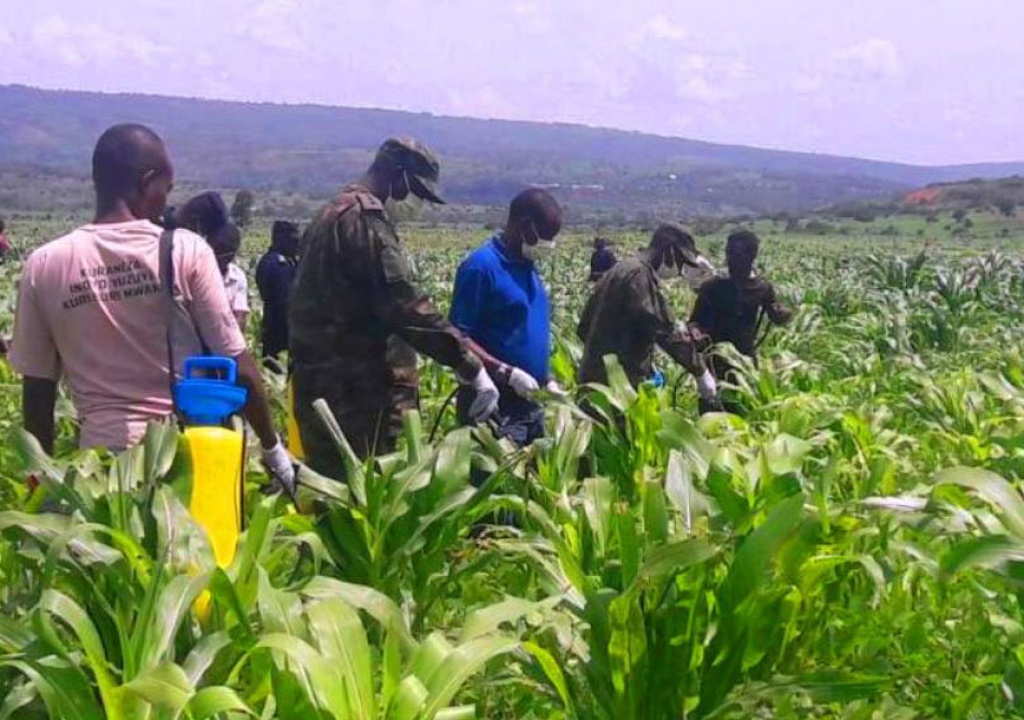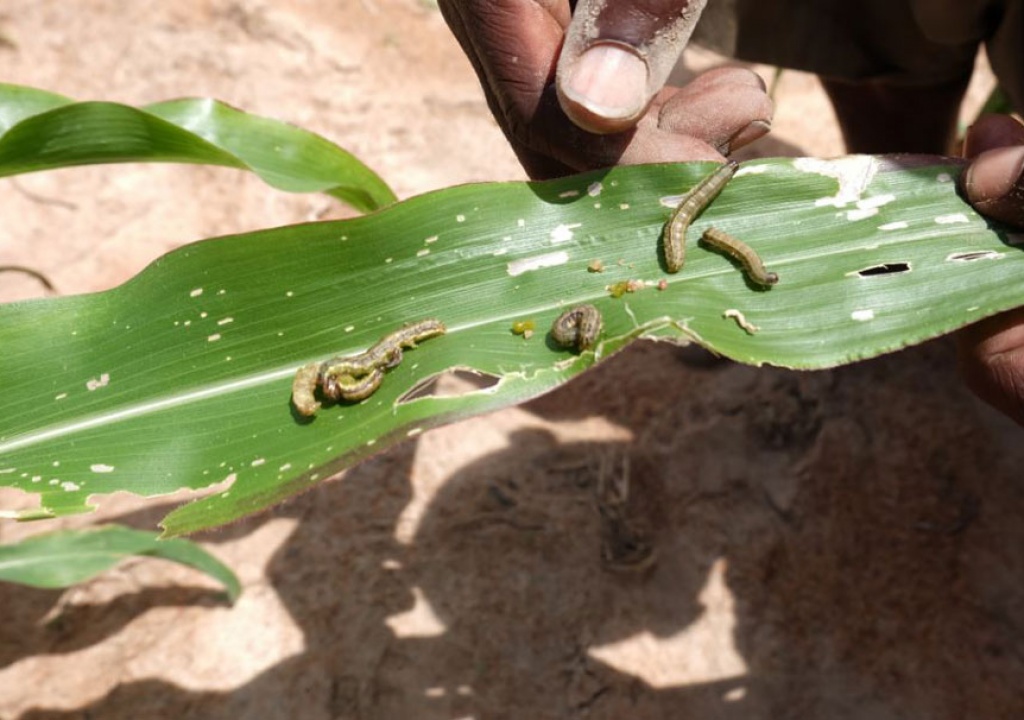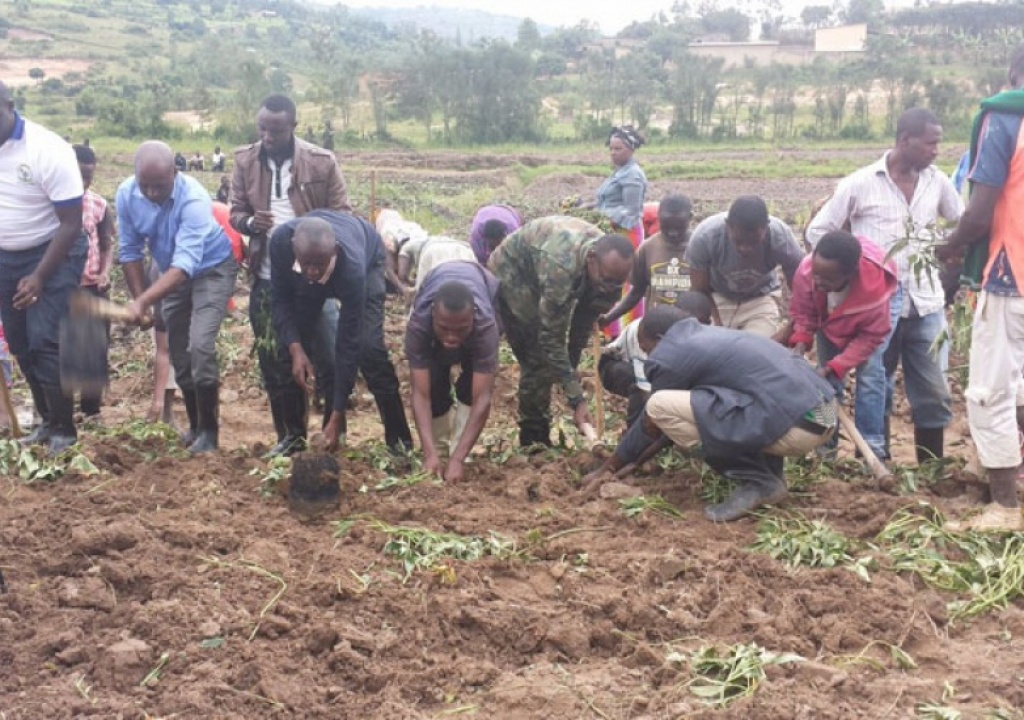
Rwanda Defence Forces (RDF) in the battle against the army worm
As all farmers across Rwanda welcomed 2017, they didn’t expect that the first crop season would slide into a scary crisis which would even attract attention of the Military.
In February, a strange pest (fall army worm) was found feasting on maize crops- they spread so fast destroying several hectares in the sectors of Uwinkingi and Kibilizi in Nyamagabe District.
The damage was so fast and wide. By mid-March, all Districts of Southern Province had reported the pest. In a few weeks, the worm had attacked all 30 districts in the country.
According to the Ministry of Agriculture, the worm had destroyed 15,699ha, representing 24.7% of the total area of 63,499ha planted maize and sorghum countrywide.
However, the Rwanda Defence Forces (RDF) intervened directly and confronted the army worm. It was a tough battle ensuring rapid delivery of required insecticides using helicopters.
Several hectares of crops were rescued.

The Fall army worm in action against maize leaves
Jean de Dieu Niyibizi, a farmer from Gakenke Sector in Gakenke District was also affected by the army worm attack but intervention from RDF was worth it.
In April, when the outbreak hit, he had maize in blossom on three hectares in Kagoma marshland-Gakenke Sector. He harvested 10 tons of maize.
Niyibizi told KT Press that 2 tons of maize was saved for household food and seeds, three others were stored with the cooperative and 5 tons put onto market at Rwf300/kg.
“I had a bank loan requested to boost my production and obtained Rwf1,500,000 from maize harvest to service a credit beforehand,” Niyibizi said.
“There is no problem of food at home and I got enough seeds to grow this season which enabled me to expand my agriculture to five hectares,” Niyibizi told KT Press.
Niyibizi’s success is attributed to coordinated efforts from various stakeholders invested in the battle of army worm. The key player was Rwanda Defense Forces (RDF).
For Niyibizi, the intervention of RDF particularly saved farmers to turn imminent bleak future into bright one.

The RDF and residents planting sweet potatoes
The outbreak was reported in 108 sectors (out of 416 of the country) in 23 districts (out of 30 districts), and affected more than 15,000 hectares of maize and sorghum crops.
The affected area represents 24.7% of the total area of 63,499 hectares on which maize and sorghum are planted countrywide, according to Rwanda Agriculture Board (RAB).
The attack on maize and beans which are staple foods in Rwanda raised concerns and fears for a looming food crisis across the country. The intervention of the army bore fruit where the outbreak didn’t affect farmers’ production.
Through the army’s annual outreach program-“army week” the military launched a campaign to grow sweet potatoes on idle arable land.
Two weeks after the launch of army week, RDF planted more than 40 hectares.
“We have been doing this for the past years, and we pledge to continue partnering with community to ensure rapid development,” Gen. Patrick Nyamvumba, Chief of Defense Staff said then.
“This is also part of the continuous liberation journey. Of course, we ended the biggest liberation struggle but the journey to withstand what we struggled for, as well as build self-reliance continues. Therefore, we shall continue having such community-based activities,” Gen. Nyamvumba added.
Banning Importation off eggs
Apart from agriculture, livestock was not free from the outbreaks. The presence of avian flu in Uganda, the key supplier of chicks and eggs to Rwanda pushed the country to suspend all poultry imports from Uganda until further notice.
The same measure aimed at containing the disease imposed on Rwanda by DRC, the main market for eggs and meat from Uganda and Rwanda which put farmers in discomfort zone.
Rwanda imports about 300,000 eggs from Uganda alone every week and 150,000 day-old chicks every month from Uganda, Belgium and Holland.
However, Uzima Chicks an Ethiopian-based Poultry Company has since ventured into the hatchery business. The Rwf 300 million hatchery is expected to produce 200,000 chicks every year.
Uzima Chick Company is set to export its products to DRC by January 2018.

Over 100 cows were quarantined to stop the spread of the foot and mouth disease
Livestock not spared
Except the avian flu, livestock farming was also in November hit by foot-and-mouth disease affecting especially the cattle. The infectious disease was traced to Ryabega Cell, Nyagatare District where 13 cows belonging to one farmer affected.
Rwanda Agriculture Board (RAB) banned cattle movements and markets in the area and establishment of the emergency treatment center resulted in the containment of the outbreak.
In May, the foot and mouth disease broke out in Gabiro area in Nyagatare District. Over 100 cows were quarantined to stop the spread of the disease.
The agriculture sector which employs over 70% of Rwandans also recorded long drought especially in the Eastern Province. The prolonged drought ravaged crops and pasture putting lives of people and cattle at risk.
While presenting its agriculture status to International Monetary Fund (IMF), government said the drought experienced between 2015 and 2016 caused crop failure of over 23,000 hectares and loss of about 2,000 cows.
The Ministry of Agriculture and Animal husbandry (MINAGRI) announced in November that it will establish a guarantee fund for 450,000 cattle which represent 30% of the country livestock. The total number of cattle in the country is 1,500,000.
The main livestock stronghold areas such as: Nyagatare, Gicumbi, Musanze, Gatsibo, Kayonza, Burera, Ruhango and Nyanza will benefit from that fund and extended to other districts. This will put an end to losses incurred by livestock farmers during outbreaks like foot and mouth disease.
Irrigation System entrenched
In response to drought, Rwanda has irrigated 43,000 hectares and 13 valley dams were constructed to ease acute water shortage in the Eastern Province, the most affected area in the country.
The government plans to irrigate 100,000 hectares by 2018 and to meet this target the government has started a scheme of covering 50% of small-scale irrigation facilities in Nyagatare and Kayonza Districts.
Tea Farmers Smile to the bank
On the other hand, what was misery to tea farmers in Rusizi District turned into smiles in November when Sir Ian Wood, a Scottish businessman and billionaire with a net worth $1.46 billion invested in tea farming in Shagasha tea factory.
Wood who is also the chairman of The Wood Foundation (TWF) acquired 55% shares in Mulindi (Gicumbi) and 60% shares in Shagasha (Rusizi district) tea factories. The two factories combined produce about 23% of Rwanda’s total tea output.
Tea growers started earning profits from tea and capped by rewarding farmers who have easily adopted the modern tea farming practices.

